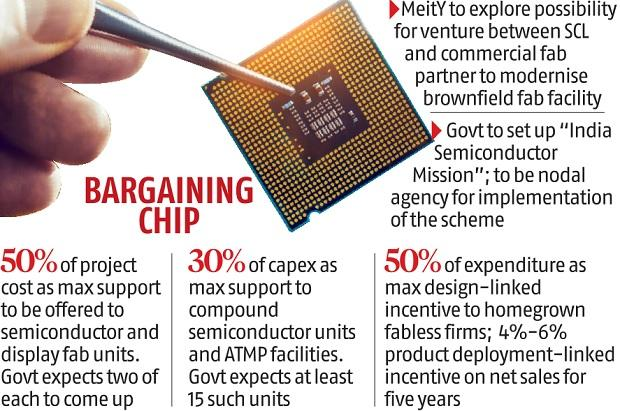[ad_1]
Context:
The Union Cabinet’s decision to set aside ₹76,000 crore for supporting the development of a ‘semiconductors and display manufacturing ecosystem’ is a belated but welcome acknowledgment of the strategic significance of integrated circuits, or chips, to a modern economy.
The Cabinet decision to simultaneously establish an India Semiconductor Mission helmed by ‘global industry experts’ to drive long-term strategies for the sustainable development of the chip and display industry is therefore a step in the right direction.
Importance of Semiconductor chips:
- Semiconductors and displays are the foundation of modern electronics driving the next phase of digital transformation under Industry 4.0. Semiconductors and display manufacturing is very complex and technology-intensive sector involving huge capital investments, high risk, long gestation and payback periods, and rapid changes in technology, which require significant and sustained investments.
- The program will give an impetus to semiconductor and display manufacturing by facilitating capital support and technological collaborations.
- The basic building blocks that serve as the heart and brain of all modern electronics and information and communications technology products, the ubiquitous chips are now an integral part of contemporary automobiles, household gadgets such as refrigerators, and essential medical devices such as ECG machines.
- The COVID-19 pandemic has dramatically thrown into sharp relief the vulnerability that a range of manufacturing industries and, by extension, national economies are exposed to in the face of disruptions in the supply of these vital semiconductors.
- The pandemic-driven push to take sizeable parts of daily economic and essential activity online, or at least digitally enable them, has also highlighted the centrality of the chip-powered computers and smartphones in people’s lives.
- With the bulk of semiconductor manufacturing and supply capability concentrated in a handful of countries including Taiwan, South Korea, U.S., Japan and, more recently, China, governments worldwide have realised that it is in the national interest to treat chip manufacturing as a strategic imperative.
Need for the India Semiconductor Mission:
In the current geopolitical scenario, trusted sources of semiconductors and displays hold strategic importance and are key to the security of critical information infrastructure.
The approved program will propel innovation and build domestic capacities to ensure the digital sovereignty of India.
It will also create highly skilled employment opportunities to harness the demographic dividend of the country.
Development of semiconductor and display ecosystem will have a multiplier effect across different sectors of the economy with deeper integration to the global value chain.
Challenges that need to be addressed:
The challenge ahead, however, is fairly daunting.
- For one, the level of fiscal support currently envisioned is minuscule when one considers the scale of investments typically required to set up manufacturing capacities in the various sub sectors of the semiconductor industry.
- A semiconductor fabrication facility, or fab, can cost multiples of a billion dollars to set up even on a relatively small scale and lagging by a generation or two behind the latest in technology.
- Even granting that India’s Production Linked Incentive scheme intends to give only 50% of the cost of setting up at least two greenfield semiconductor fabs by way of fiscal support, not much of the current scheme outlay of approximately $10 billion is likely to be left to support other elements including display fabs, packaging and testing facilities, and chip design centres.
- Chip fabs are also very thirsty units requiring millions of litres of clean water and extremely stable power supply.
- India has a decent chip design talent but it never built up chip fab capacity. The ISRO and the DRDO have their respective fab foundries but they are primarily for their own requirements and also not as sophisticated as the latest in the world.
- It may be best if the new mission focuses fiscal support, for now, on other parts of the chip-making chain including design, where surely India already has considerable talent and experience.
Way Forward:
- Given the long gestation periods and rapid technology changes, India must out-strategize on design and functionality as the end product will be out only after three-four years from the moment work begins, by which point the prevailing chip shortage would have been resolved, while technology would have advanced further.
- India needs to push for a Quad Supply Chain Resilience Fund to immunise the supply chain from geopolitical and geographic risks
- India and Taiwan have started negotiations for a free-trade agreement and setting up a semiconductor manufacturing hub in an Indian city, signalling their resolve to further expand the two-way economic engagement.
Conclusion:
The program will usher in a new era in electronics manufacturing by providing a globally competitive incentive package to companies in semiconductors and display manufacturing as well as design.
The program will promote higher domestic value addition in electronics manufacturing and will contribute significantly to achieving a USD 1 Trillion digital economy and a USD 5 Trillion GDP by 2025.
This shall pave the way for India’s technological leadership in these areas of strategic importance and economic self-reliance.
[ad_2]


